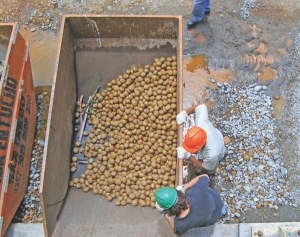Latin America-focused Yamana Gold (YRI-T, AUY-N) is selling its three most costly gold mines to Aura Minerals (ORA-T, ORAUF-O) for US$200 million, putting some analysts on the lookout for a Yamana shopping spree to make up for the lost production.
Aura, a copper development company, will buy the San Andres gold mine in Honduras and the Sao Francisco and Sao Vicente gold mines in Brazil, which together produce 220,000 oz. gold per year at an average cash cost of US$550 per oz.
Yamana says the deal, which will allow it to focus on its six core operating mines and its higher-returning development projects, will help streamline its portfolio and lower cash costs. The company produced 1 million gold-equivalent oz. in 2008 costing US$387 per oz., and expects to produce 1.35 million gold-equivalent oz. this year.
But some analysts say Yamana sold the mines on the cheap, even though the US$200-million price tag gives the company 40 million Aura shares at 40¢ each and the potential to make an extra US$40 million through a royalty that’s contingent on cash flow from the three mines.
Richard Gray of Blackmont Capital, who estimates that Yamana’s average cash costs will fall by about US$35 per oz., agrees that streamlining its assets was a good idea, but notes in a June 10 report: “the sale price was well below what we would have expected.”
David Stein of Cormark Securities values the three mines at US$400 million — that’s twice the sale price. In a June 11 note, Stein points out that gold miners are valued at a premium in the market to mine for gold, not to hoard cash. Yamana had US$347 million in cash at the end of the first quarter.
“It is hard to see this as a good move in the short term,” Stein wrote in a report following the announcement. “However, if Yamana can redeploy its capital into perhaps one single larger operation to replace the three that it is losing, it could ultimately be accretive.”
BMO Capital Markets analyst David Haughton agrees that the sale will rationalize Yamana’s asset base but says it’s dilutive to both Yamana’s net asset value per share and earnings per share. He also says letting go of the mines could prevent the company from meeting its production goals.
“It puts them a little farther away from their goal of two million ounces by 2012,” Haughton says.
Yamana made no mention of a change to its production goals in its announcement, but Haughton says that buying a new project could be the next step.
“Divesture of non-core assets is one part of rationalization; the acquisition of new projects is the other part of it,” Haughton says.
Yamana chairman and CEO Peter Marrone, who was unavailable for comment, said in a statement that the sale will lower the company’s cash costs, improve margins, and increase reserves, production and cash flow per mine.
“We believe we will derive significantly more value from our share position than had these mines remained directly held by our company, particularly in a higher gold price environment,” Marrone said.
The companies are very familiar with one another. Neither Marrone nor Aura chairman Patrick Mars were involved in the deal making as both sit on the board of the other company. Marrone held 29.7 million Aura shares worth about 5% of Aura at the time of the deal. Also of note, Aura president and CEO Patrick Downey was in charge of Viceroy Exploration before it was bought out by Yamana in 2006 for US$600 million.
At presstime, Yamana shares had fallen about 12% to $10.58 but Aura shares had jumped more than 50% to 67¢.
Downey says cash flow from the mines will help Aura pay for the development of its Arapiraca copper-gold-iron ore project in Brazil. He says that although the company will be bringing its Aranzazu copper-gold-silver project in Mexico into production next year, contributing $30 million in cash flow, the company was still worried about funding.
“That’s not enough to finance our Arapiraca project, so we were betwixt and between,” he says. “We felt that getting production, getting cash flow would release that overhang and allow the company to execute its business plan.”
Unlike Yamana, Aura will treat the three mines as core projects and because of this, Downey believes the cash costs can be brought down below US$500 per oz. “We have ideas for reduction of cash costs and we think they’re very doable,” he says.
Under the terms of the deal, Aura will pay US$90 million in cash, US$70 million in deferred cash payments and US$40 million in Aura shares at 40¢ apiece.
By June 15, Aura had announced a $100.1-million bought-deal financing required for the deal to go through, noting that no officers or directors from either company participated. Aura will issue 182 million subscription receipts at 55¢ apiece to a syndicate of underwriters led by Canaccord Capital. The group will have the option to buy another $25 million in subscription receipts at the same price.
The transaction will close in two parts; the sale of San Andres is expected to close on July 23 at which time Aura will pay Yamana US$74 million. Aura will have to wait about six months before the two Brazilian mines, Sao Francisco and Sao Vicente, can be officially turned over due to jurisdiction-related regulatory requirements.
When all is said and done, Aura will have issued 337 million new shares. The company currently has 593 million shares outstanding. However, once the San Andres deal is complete, Aura will do a five-for-one share consolidation.


Be the first to comment on "Yamana Sells Off Mines To Aura"